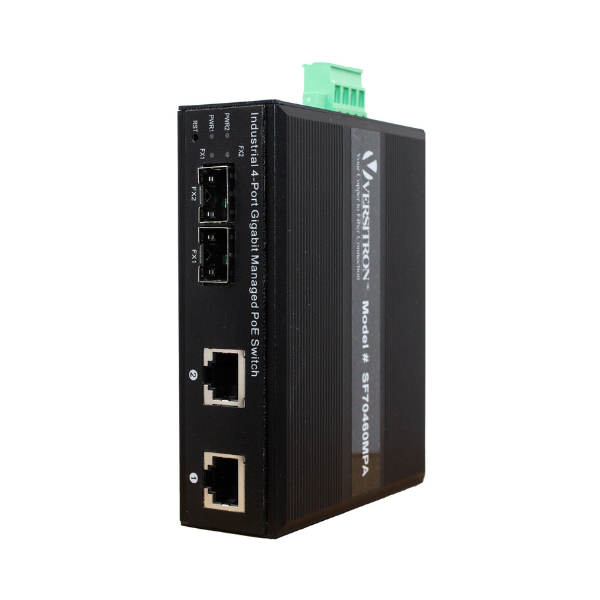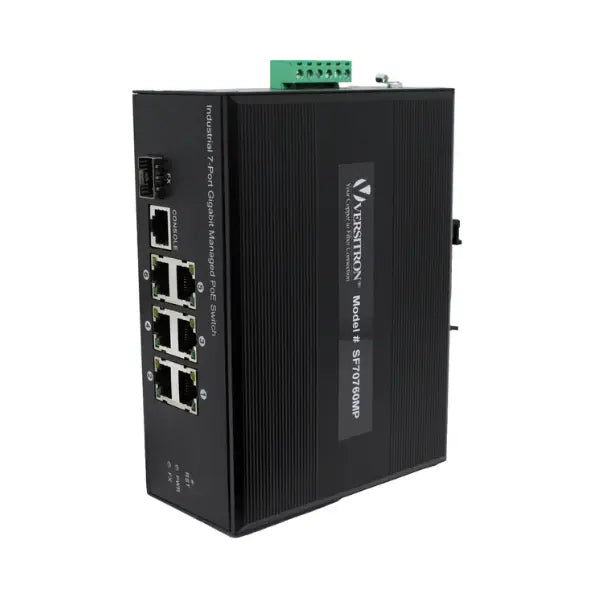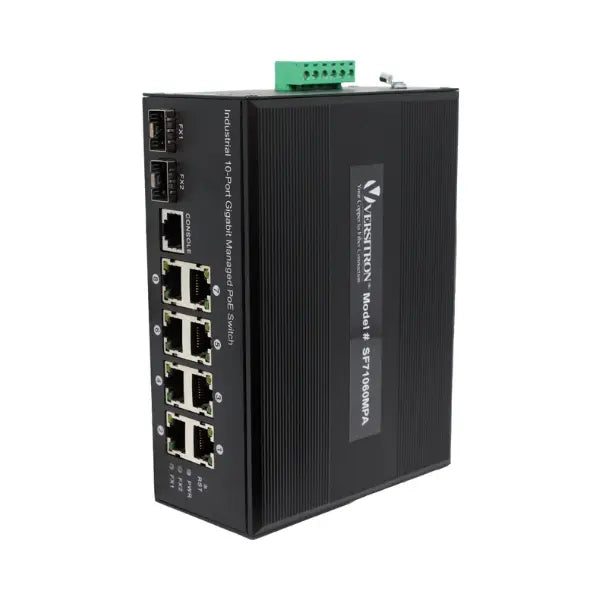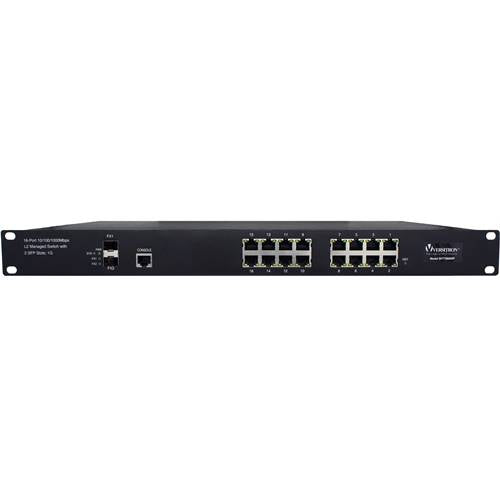In the intricate landscape of modern networking, devices which are utilizing PoE, ensure efficient and reliable connectivity. This blog delves into the intricacies of PoE devices such as PoE injectors, PoE switches, PoE media converters, and PoE splitters, which are installed especially in blended networks such as copper and fiber ones. Understanding these devices is crucial for optimizing home networks or managing large-scale deployments.

What are PoE Extenders?
PoE Extenders extend the reach of PoE-enabled devices beyond their traditional limitations. These devices act as power and data boosters, allowing you to connect and power remote network components that would otherwise be out of reach. Imagine seamlessly powering and connecting surveillance cameras, access points, and other devices in far-off corners of a building without the need for additional power sources or complex cabling.
How Does PoE Extender Works?
A PoE extender, also known as a PoE repeater, operates on the principle of signal regeneration and power amplification. It serves as an intermediary device between the PoE switch and the powered device (PD), ensuring that both power and data signals remain strong and steady, even over extended cable lengths.
When the PoE switch sends out power and data signals to the PD through an Ethernet cable, these signals start to weaken as the cable length increases. This attenuation can lead to a decrease in network performance and potentially disrupt the connection. Here's where the PoE extender steps in. It receives the weakened signals from the PoE switch, amplifies them, and then retransmits them to the PD. This process effectively extends the reach of the network while maintaining signal integrity.
The Inner Workings of PoE Extender
To better understand how PoE extenders work, let's break down their inner workings into a few key steps
- Signal Reception: The PoE extender receives weakened power and data signals from the PoE switch via an incoming Ethernet cable.
- Amplification: The device amplifies both the power and data signals, ensuring that they regain their strength and clarity.
- Signal Transmission: The extender then transmits the amplified signals through an outgoing Ethernet cable, which leads to the PD.
- PD Connection: The powered device (PD) receives the reinvigorated signals and can operate seamlessly without any signal degradation.
Also read: How Does a PoE Switch Work?
What Are the Advantages of PoE Extender?
- Extended Reach: PoE extenders allow devices to be located farther from the power source, expanding the network's coverage area.
- Cost Savings: Avoid the expenses of additional power cabling and outlets in hard-to-reach locations.
- Simplified Infrastructure: With extended reach, there's less need for multiple power sources, simplifying network architecture.
- Reduced Downtime: PoE extenders enhance network reliability by ensuring continuous power to remote devices.
- Easy Installation: PoE extenders are plug-and-play devices, making installation hassle-free and requiring minimal technical expertise.
- Network Flexibility: These extenders enhance the flexibility of network design, allowing for dynamic layouts and adaptability to evolving infrastructure needs.
- Maintained Performance: With signal amplification, network performance remains consistent even in challenging environments.
Different Types of PoE Extenders
- Ethernet Extenders: Ethernet PoE Extenders focus on extending network connections through physical cabling. These extenders are an ideal choice when you need to span longer distances within a wired infrastructure. They are particularly useful in scenarios where deploying new Ethernet cables is impractical or expensive. Ethernet Extenders are capable of boosting signals while maintaining high data transfer rates, making them a reliable solution for environments that demand consistent and efficient connectivity.
- Wireless Extenders Wireless PoE Extenders, on the other hand, offer a flexible solution for extending networks without the constraints of physical cabling. These devices leverage wireless communication to transmit both power and data signals across expansive areas. Whether you need to cover outdoor spaces, large warehouses, or sprawling campuses, wireless PoE Extenders provide a cost-effective means of achieving seamless connectivity.
- Single-Port PoE Extenders: Single-port PoE extenders are the most basic type, designed to extend the reach of a single PoE-powered device. They are typically used when you need to connect a device to a network that is beyond the standard PoE range. These extenders amplify both power and data signals, allowing you to place the device at a greater distance from the power source while maintaining optimal connectivity. Single-port PoE extenders are commonly used in applications such as IP cameras, Wi-Fi access points, and VoIP phones.
- Multi-Port PoE Extenders: Multi-port PoE extenders take network expansion to the next level by allowing you to connect multiple devices simultaneously. They come equipped with multiple Ethernet ports, each capable of extending both power and data signals. This type of extender is particularly useful in scenarios where several devices need to be placed at a distance from the power source, such as in large office spaces or industrial environments.
- Fiber Optic PoE Extenders: Fiber optic PoE extenders combine the benefits of PoE technology with the high-speed capabilities of fiber optics. These extenders are ideal for situations where extremely long distances need to be covered while maintaining high data transfer rates. Fiber optic PoE extenders are commonly used in applications like connecting remote buildings, campuses, or data centers.
- Plug-and-Play PoE Extenders: Plug-and-play PoE extenders are designed for hassle-free installation and use. They require minimal configuration and can be easily integrated into existing PoE networks. These extenders are suitable for users who are looking for a straightforward solution to extend network connectivity without the need for complex setups.
- Wall-Mount PoE Extenders: Wall-mount PoE extenders are compact devices that can be easily mounted on walls or other surfaces. They are commonly used in environments where space is limited or where aesthetics play a role. Wall-mount extenders offer the advantage of being discreet while providing effective network extension capabilities.
How to Use the PoE Extender?
- Select the Right Extender: Choose an extender compatible with your network's PoE standard and the distance you need to cover.
- Connect the Extender: Plug one end of the Ethernet cable into the PoE injector and the other end into the extender's input port.
- Extend the Reach: Run an Ethernet cable from the extender's output port to the remote device's location.
- Power On: Ensure the extender is powered using either a power outlet or PoE, depending on its design.
Also read: Extending PoE Distance: Unlocking the Maximum Reach for Power over Ethernet
What is a PoE Injector?
A PoE injector plays more of a supporting or supplementary role. It provides power in a non-PoE network. Such networks may have a regular Ethernet switch without the PoE feature. The injector and the non-PoE switch are connected to an Ethernet cable and powered on. Overall, with injector, you can connect various other smart devices, such as phone, IP camera, and so on, onto the network.
A PoE injector primarily enables you to connect a PoE-enabled device to a non-PoE port. This way, PoE-enabled device can transfer electric energy as well as receive data over the network.
The Mechanics of PoE Injector
Understanding how a PoE injector operates is key to comprehending its significance in modern networking setups. The injector works by injecting electrical power into the Ethernet cable, using a process called modulation. Modulation involves superimposing direct current (DC) onto the alternating current (AC) data signal. The receiving end, typically a PoE-enabled device like an IP camera or wireless access point, then separates the power from the data, putting each to its intended use
How Does the PoE Injector Work?
The PoE injector operates on a simple yet ingenious principle. It seamlessly integrates power and data transmission by combining electrical power and network data into a single Ethernet cable. This eliminates the need for separate power cables, reducing clutter and installation complexity.
- Power Sourcing Equipment (PSE): The PoE injector typically resides within a network switch or a dedicated injector device. It serves as the power sourcing equipment, responsible for supplying direct current (DC) power over the Ethernet cable.
- Data and Power Integration: When a PoE-enabled device, such as an IP camera or wireless access point, is connected to the Ethernet cable, the PSE detects its power requirements. It then integrates both data and electrical power onto the same cable, using a technique called modulation.
- Modulation: The PSE modulates the DC power onto the Ethernet cable by superimposing a low-level DC voltage onto the data signals. This modulation is achieved without disrupting the data transmission process, ensuring a seamless flow of information.
- Device Detection: Before supplying power, the PSE performs a device detection process to ensure compatibility. It sends a low voltage signal to detect if the connected device is PoE-compliant. If the device responds positively, the PSE proceeds with power delivery.
- Power Delivery: Once compatibility is confirmed, the PSE provides the appropriate amount of power needed by the connected device. This can vary based on the device's power requirements.
- Device End (Powered Device): On the receiving end, the connected device, often referred to as the "powered device," extracts the DC power from the Ethernet cable using a specialized interface. Simultaneously, it extracts the data signals and processes them.
PoE Injector Function
PoE injectors, also known as midspan devices, are power supply units that inject electrical power into Ethernet cables, allowing both data and power to be transmitted over a single cable. They are often used in situations where existing network infrastructure needs to be upgraded to support PoE. PoE injectors bridge the gap between non-PoE switches and PoE-compatible devices, enabling devices like IP cameras, VoIP phones, and wireless access points to operate without the need for separate power cables.
The operation of a PoE injector is relatively straightforward. It takes power from a standard electrical outlet and delivers it to the Ethernet cable, which then carries both power and data to the connected device. This eliminates the need for separate power sources and simplifies installation, making Poe injectors an excellent choice for retrofitting existing setups with PoE capabilities.
What Are the Advantages of Using a PoE Injector?
- Simplified Installation: PoE injectors eliminate the need for additional power cables, streamlining installations and reducing clutter.
- Flexibility: Devices can be placed in locations without easy access to power outlets, offering greater flexibility in network design.
- Cost Efficiency: By combining data and power transmission, operational costs are reduced as there's no need for separate electrical wiring.
- Remote Management: PoE-enabled devices can be remotely powered down or rebooted, enhancing network management capabilities.
- Scalability: Easily expand your network without worrying about power source availability, making scalability hassle-free.
How to Use a PoE Injector?
- Choose the Right Injector: Select an injector compatible with your device's power requirements and the Ethernet standard being used.
- Connect the Injector: Plug one end of the Ethernet cable into the injector's LAN port and the other end into your network switch or router.
- Connect the Device: Connect the PoE-enabled device to the injector's PoE port using another Ethernet cable.
- Power On: Plug the injector into a power outlet. The injector will provide power to the device through the Ethernet cable.
Do You Need a PoE Injector?
PoE injectors, often referred to as PoE adapters, are devices designed to transmit electrical power along with data through Ethernet cables. If you find yourself in any of the following scenarios, a PoE injector might be exactly what you need:
- Running Devices in Remote Locations: Are you managing devices in hard-to-reach spots without easy access to power outlets? PoE injectors can be a lifesaver. They eliminate the need for dedicated power sources, simplifying installations and reducing clutter.
- Enhancing Network Flexibility: Do you dream of rearranging your network devices without worrying about proximity to power outlets? PoE injectors provide the flexibility to position devices exactly where you want them, regardless of electrical outlets.
- Cutting Installation Costs: Tired of running separate power cables alongside your Ethernet cables? PoE injectors streamline your setup by combining power and data transmission into a single cable, saving you both time and money.
Types of PoE Injectors
- Industrial PoE Injectors: In demanding industrial environments, industrial PoE injectors excel. They're engineered to withstand extreme temperatures, vibrations, and electrical interference, making them perfect for manufacturing plants and warehouses.
- Managed PoE Injectors: When you require granular control over your network, managed PoE injectors deliver. These injectors allow you to remotely monitor and manage power distribution to individual devices, optimizing efficiency.
- Unmanaged PoE Injectors: Unmanaged PoE injectors, on the other hand, offer a plug-and-play experience without the need for complex configurations. They're great for simple setups in smaller environments.
- Rack-Mountable PoE Injectors: For centralized installations, rack-mountable PoE injectors fit neatly into server racks, saving space while providing power to multiple devices like switches, routers, and servers.
- Wall-Mountable PoE Injectors: When wall mounting is preferred, wall-mountable PoE injectors offer a space-efficient solution. They're commonly used in offices and retail environments for devices like Wi-Fi access points and IP phones.
What is PoE Switch?
PoE switch is a network switch that comes with a built-in injector. There are PoE and PoE+ switches, wherein the latter is an updated version of the former and offers double the amount of electric energy. PoE switches use the IEEE 802.3af standard, while PoE+ switches use IEEE 802.3at.
These are managed switches that automatically determine the compatibility with other devices on the network. Usually, these switches have 8 ports or more. There are ports for copper as well as fiber networks, and hence most of these switches are compatible for both or blended networks.
What is PoE Splitter?
These devices are combined with PoE injectors and PoE switches. Unlike other PoE devices, these devices do not take power and data input to turn them into a single output, rather they split the data and power and feed the power to the separate input. Generally, the PoE splitters are used in the scenario where non-PoE devices and no AC outlets are found.
How Does PoE Injector Work with Splitter for Power over Ethernet?
When a PoE splitter is used with a PoE injector, the injector sends both power and data through the Ethernet cable. The splitter then separates the power from the data, allowing you to connect non-PoE devices to the network while still receiving power. This combination of injector and splitter provides versatility in powering a mix of PoE and non-PoE devices.
PoE Splitter for Two Devices: Doubling the Efficiency
A fascinating application of PoE technology involves using a PoE splitter for two devices. Imagine you have a single PoE-enabled Ethernet cable and two devices that require power and data connectivity. This is where a PoE splitter for two devices comes into play. This innovative device takes the incoming power and data signals and splits them into two separate streams, catering to the power and data needs of each device.
This setup is exceptionally useful in scenarios where running multiple Ethernet cables is impractical or costly. By using a PoE splitter for two devices, you can efficiently power and connect devices like IP cameras or access points without the need for excessive cabling. This not only reduces clutter but also streamlines installation and maintenance processes.
How to Install a PoE Splitter?
- Choose a Compatible Splitter: Select a splitter that matches your network's PoE standard and voltage requirements.
- Connect the Splitter: Plug the Ethernet cable from the injector into the splitter's input port.
- Separate Power and Data: Connect the output ports of the splitter to your PoE and non-PoE devices using Ethernet cables.
- Power Up: Plug the splitter into a power outlet, providing power to the non-PoE devices while maintaining data connectivity.
Now that we're familiar with all PoE devices, let's compare them to understand their respective benefits and applications relative to each other.
PoE Extenders vs. PoE Injectors
PoE Extenders: Extending Reach and Connectivity
On the other hand, PoE extenders, also referred to as PoE repeaters, are designed to extend the reach of PoE networks beyond the standard 100-meter Ethernet cable limitation. These devices receive both power and data from the source and then regenerate and retransmit the signals, enabling network expansion to remote locations.
Key Benefits of PoE Extenders:
- Extended range: PoE extenders can amplify signals up to several hundred meters, extending network coverage.
- Remote installations: They enable deployment in locations where direct power access is challenging.
- Scalable networks: Extenders facilitate the growth of networks without compromising performance.
- Flexibility: PoE extenders support various Ethernet standards and can be used with multiple devices.
PoE Injectors: Delivering Power and Data
PoE injectors, also known as PoE adapters, serve as an intermediary between a standard Ethernet switch and non-PoE compliant devices. These devices inject power into the Ethernet cable, allowing devices like IP cameras, VoIP phones, and wireless access points to receive both data and power through a single cable. PoE injectors are a viable option when upgrading existing non-PoE infrastructure, avoiding the need for a complete network overhaul
Key Benefits of PoE Injectors:
- Streamlined installations: PoE injectors simplify setups by eliminating the need for separate power cables.
- Versatile compatibility: They can be used with various devices, even those lacking inherent PoE support.
- Cost-effective upgrades: Injectors allow gradual integration of PoE devices, reducing upfront costs.
- Power delivery control: Some injectors offer power management options for efficient energy utilization.
Applications of PoE Injectors vs. PoE Extenders
Making the Most of PoE Extenders
PoE extenders play a vital role in network expansion across larger areas. Their applications include:
- Connecting remote IP cameras in expansive surveillance setups.
- Linking distant wireless access points in outdoor deployments.
- Enabling PoE-powered devices in industrial environments with challenging layouts.
PoE Injectors in Action
PoE injectors find applications in scenarios where integrating PoE devices into existing non-PoE networks is essential. They're commonly used in:
- Retrofitting security systems with PoE-enabled cameras
- Adding PoE support to non-PoE switches for powering VoIP phones.
- Upgrading Wi-Fi access points with minimal disruption.
PoE Injector vs PoE Switch
The decision between a PoE injector and a PoE switch largely depends on the specific requirements of the network setup. Here are some factors to consider when making this choice:
PoE Switch vs. PoE Splitter
PoE Switch: Empowering Network Efficiency
A PoE switch is a powerful networking device that not only transmits data but also provides electrical power to PoE-enabled devices. Unlike traditional switches, PoE switches eliminate the need for separate power cables, making installations cleaner and more streamlined.
These switches intelligently manage power distribution, ensuring optimal energy utilization across connected devices. By centralizing power delivery, PoE switches offer enhanced control and monitoring capabilities, making them ideal for managing larger networks, such as offices, campuses, and industrial settings.
PoE switches come in two main types: industrial and commercial. Industrial PoE switches are built to withstand tough conditions like extreme temperatures and harsh environments. On the other hand, commercial PoE switches are designed for less demanding environments.
PoE Switch Advantages:
- Centralized Power Management: Efficiently control and allocate power to connected devices.
- Scalability: Easily expand your network by adding more PoE-enabled devices without compromising power delivery.
- Network Monitoring: Gain insights into device status, power consumption, and performance.
PoE Splitter: Enhancing Flexibility
On the other hand, a PoE splitter serves a different purpose. It's employed when a non-PoE device needs to be powered using PoE technology. This device takes the PoE input from an Ethernet cable and separates it into two outputs: data and power.
The data output is then connected to the non-PoE device, while the power output supplies energy to it. This allows you to retrofit non-PoE devices into a PoE network without the need for extensive rewiring or additional power sources. PoE splitters are particularly useful for upgrading legacy systems, such as IP cameras or access points, to PoE connectivity.
PoE Splitter Advantages:
- Cost-Effective Retrofitting: Upgrade non-PoE devices to PoE without the need for extensive modifications.
- Simplified Installation: Avoid the hassle of running additional power cables, reducing clutter and installation time.
- Versatility: Integrate a variety of legacy devices into your PoE network, extending the lifespan of your existing infrastructure.
PoE Splitter vs PoE Injector: Making the Choice
When considering whether to use a PoE splitter or injector, it's important to understand the differences and benefits of each. A PoE injector, as mentioned earlier, injects power into the Ethernet cable, while a PoE splitter does the opposite: it separates the power from the data. PoE splitters are particularly useful when you want to power non-PoE devices using a PoE network.
For instance, if you have a non-PoE device that you want to connect to a PoE network, you can use a Poe splitter. The splitter will take the combined power and data signal from the Ethernet cable and split it into separate power and data streams, allowing you to power the device using a conventional power adapter while still benefiting from the data transmission through the Ethernet cable.
Conclusion
In conclusion, this comprehensive guide has illuminated the diverse functionalities and applications of PoE extenders, PoE injectors, PoE splitters, and PoE switches. Understanding their roles empowers efficient network design, enabling seamless integration of power and data transmission. Harnessing these technologies optimizes network performance, scalability, and cost-effectiveness in various industries.
If you are considering using these devices, it is essential to source them from authorized and certified manufacturers like VERSITRON. You can get in touch with the experts at the company to make a wise selection.









